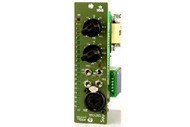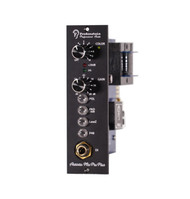- Home
- 500 Series
- Trident 80B Mic Pre
Product Description
Trident Audio Developments
The Mic Pre
Taken from the legendary Trident Series 80B console of the early 1980’s, the 500 Series 80B Preamp provides the user with the classic mic preamp in a modern 500 Series format.
Features include.
- High-quality transformer-coupled microphone amplifier
- 48-volt switchable Phantom Power
- High-quality Output transformer
- Electronically balanced Line Input amplifier
- Separate Microphone & Line level controls
- Front facing (Hi Z) ¼” Line Input
- Variable Low Pass Filter (LPF)
- Variable High Pass Filter (HPF)
- Switchable Phase control (Polarity)
- Output meter LED VU display
The Mic Pre
The 80B MIC PRE amplifier is of a unique design that is able to handle signal levels from -60dBu to as high as +15dBu without the use of a separate pad switch. Even though such a wide range of signal levels is accommodated, adjustment of the gain is extremely smooth, particularly at the high signal levels where other designs tend to have a cramped level adjustment at the end of the control.
In addition, it exhibits near theoretical minimum noise figures, has an extremely fast transient response, and accommodates a wide range of input levels with a frequency response that extends to above 40kHz. Naturally, best results will be achieved using a high-quality condenser microphone. The microphone amplifier will however also bring out the best in either a dynamic or ribbon microphone. The combination of high gain with low noise is particularly useful when working with ribbon microphones as most models have an inherently low output level.
Operating The Mic Pre
The microphone input is active when the front panel MIC/LINE switch is in its released state. This will appear white in color.
When connecting a microphone, set the MIC input level control to minimum (it is good practice to only engage the phantom power +48V switch with the MIC input set to minimum, as this will help avoid any audible connection noises through a speaker system).
Once connected, engage the +48V phantom power switch. Allow up to 30 seconds for the microphone to reach its normal operating level and advance the MIC gain control until a suitable level is achieved. Careful monitoring of the OUT (VU) meter whilst setting the microphone gain will help to avoid any overloading and clipping of the signal. However, the 80B MIC PRE has plenty of overload margin, as the unit is capable of extremely high output levels (up to +27dBu into a balanced load). So, by setting the levels as described, adequate headroom is maintained and there should be no danger of overloading any following equipment.
The phase or polarity (POL) reverse switch is employed when phase interference occurs between multiple microphones. Such interference results when microphones, at various placements pick up the same sound source at slightly different times. When the output of the microphones combine, cancellation occurs at certain frequencies. This effect is known as comb filtering. Switching the polarity on one of the microphones may serve to minimize this effect.
The polarity reverse switch operates on both the MIC and LINE input.
Operating the Line Input
The line input is active when the front panel MIC/LINE switch is in its depressed state. This will appear green in color.
Once a signal source is connected to the line input, adjust the LINE gain control to it’s midway point. At its midway position in line mode, the unit is designed to give unity, or ‘0’ dB gain. This makes for an easy reference point when using the line level input and a center detent is provided at the center point of the gain control for this purpose.
As with the microphone input, careful monitoring of the OUT (VU) meter whilst setting the line input level will help to avoid any overloading and clipping of the signal.
The Line Input is designed to accept balanced or unbalanced, line level audio signals.
When used with a Radial Lunchbox, the 80B MIC PRE can take advantage of the Radial Omniport which is designed to deliver module-specific functionality that can range from an extra output, key input, or effects insert depending on the module. In the case of the 80B MIC PRE, the line input is in parallel with the Omniport jack, providing an additional line input option that can be used on a Radial Lunchbox instead of the front panel Line jack.
The low and high pass filters
The filter section of the 80B MIC PRE consists of both a variable 30Hz to 350Hz high pass filter (HPF) and a variable 2KHz to 20KHz low pass filter (LPF). This can be useful for filtering out any unwanted high frequency sounds or low-end rumble for instance.
Operating the low pass filter
Engaging the LPF switch activates the low pass filter on the 80B MIC PRE. The LPF switch will illuminate red when depressed and denotes the filter is on.
Rotating the low pass filter control knob, will select the frequency at which the low pass filter effects the audio signal. The signal level passing through the low pass filter will remain at 0dBu until the frequency selected on the LPF control knob is reached and frequencies above this point will be cut at a rate of 12dBu per octave.
By switching the switching the LPF in and out, a comparison can be made between filtered and non-filtered audio signal.
Operating the high pass filter
The high pass filter works in the same way as the low pass filter. Engaging the HPF switch activates the high pass filter on the 80B MIC PRE. The HPF switch will illuminate red when depressed and denotes the filter is on.
Rotating the high pass filter control knob, will select the frequency at which the high pass filter effects the audio signal. The signal level passing through the high pass filter will remain at 0dBu until the frequency selected on the HPF control knob is reached and frequencies below this point will be cut at a rate of 12dBu per octave.
Like the low pass filter, by switching the switching the HPF in and out, a comparison can be made between filtered and non-filtered audio signal.
Specifications
Microphone Input to Output
Gain : Variable -10dB to +65dB
Bandwidth: 12Hz to 40KHz (+/- 0.5dB 20Hz to 15KHz)
Distortion: THD + Noise = <0.02% 100Hz to 20KHz (+15dBu Output)
EIN: Better than -125dBu @+65dB gain with 150 Ohms input load.
Noise: To be issued
Max Output: >27dBu To be confirmed
Hi-Z Line Input
Input Impedance: 1MΏ Balanced
Gain: +/- 20dB
Bandwidth: To be issued
Distortion: To be issued
Noise: To be issued
Low Pass Filter: Variable 30Hz to 350Hz, -12db/Octave
High Pass Filter: Variable 2KHz to 20KHz, -12db/Octave
Warranty Information
Comes with Manufacturer's Warranty
 Loading... Please wait...
Loading... Please wait...








